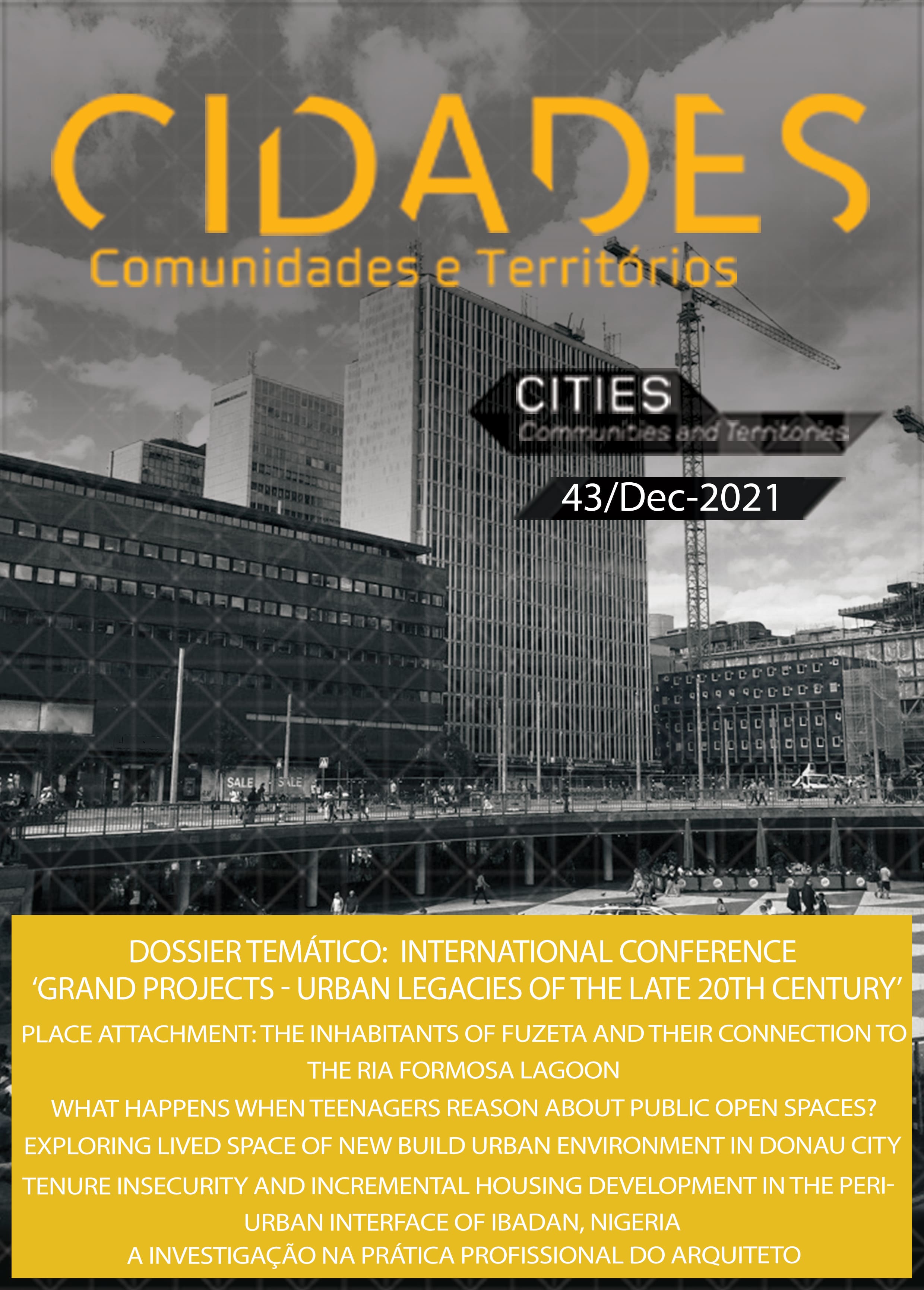The city as a text
Approximations between anthropology, urbanism and space semiotics
Keywords:
territory, space semiotics, semiosphere, LotmanAbstract
Starting form some city concepts coming from some scholars (Mumford, Benveniste, Rapoport, Heidegger, Volli) this reflection aims understand urban phenomenology. The next step is the insight of the city as a text mainly from Lotman and Hjelmslev. The Itueta (Brazil) eradication and the West End (Boston - USA) reshuffle are examples of radical changings in the urban text and their effects over their inhabitants. The cultural, sociological and psychological changings – grief, psychological pathologies, discomfort – are at stake in this analysis. So, as conclusion: city is actually the end outcome of a text – as a write down and as a testimony – stablishing deep and meaningful relationships to the life of its dwellers.
References
Américo, E. V. (2015). Iúri Lotman e a Escola de Tártu-Moscou, Galaxia, 29, 123–140.
Apadurai, A. (1997). Modernity at Large: Cultural Dimensions of Globalization. Minneapolis: University of Minnesota Press.
Bakhtin, M. (2011). Estética da criação verbal. São Paulo: Martins Fontes.
Benveniste, É. (1969). Le vocabulaire des instituitions indo-eutopéenes. Paris: Les Éditions de Minuit, 2. vol.
Brito Cardoso, N. A. (2017). Cidades criativas: por uma análise territorial simbólica. Dissertação (Mestrado em Gestão Integrada do Território) – Programa de Pós-Graduação em Gestão Integrada do Território, Universidade Vale do Rio Doce, Governador Valadares.
Bühler, K. (1934-2011). Theory of Language: The representational function of language. Amesterdam: John Benjamin.
Cazarotto, J. L., Genovez, P. F. (2015). Itueta-MG e a singularidade de seus tempos: Narrativas da erradicação de uma cidade, Anthropos (Bonn), 110(1), 88–99.
Collignon, B. (2001). Décrire la ville – la construction des sovois savoirs urbains dans l’interaction et dans le texte’ – Comptes-rendues, Cybergeo (on line). https://journals.openedition.org/-cybergeo/964#quotation.
Cunha, A. G. (1982). Dicionário Etimológico Nova Fronteira. Rio de Janeiro: Nova Fronteira.
Dubois, J., et al.(2006). Dicionário de Linguística. São Paulo: Cultrix.
Fernandez, J. W. (1986). The Argument of Images and the Experience of Returning to the Whole, in V. Turner, E. M. Bruner (Eds.), The Anthropology of Experience (pp.159-187). Urbana: University of Illinois Press.
Fried, M. (1968). Grieving for a Lost Home: Psychological Costs of Relocation, in J. Q. Wilson (Ed.), Urban Renewal: The Record and the Controversy (pp.337-379). Cambridge: The MIT Press.
Galimberti, U. (2006). Psiche e techne: o homem na idade da técnica. São Paulo: Paulus.
Giannitrapani, A. (2013). Introduzione alla semiotica dello spazio. Roma: Carocci.
Greimas, A. J., Courtès, J. (2016). Dicionário de Semiótica. São Paulo: Contexto.
Heidegger, M. 1951-1954). Construir, morar, pensar (Bauen, Wohnen, Denken). Pfüllingen: G. Neske. https://pt.scribd.com/doc/105768862/-HEIDEGGER-Martin-Construir-Habitar-Pensar.
Heidegger, Martin. (1951-2014). Bauen, Wohnen, Denken, in D. Eberle, (org.), Handwerkheft IV (pp. 102-110). Texte. Zürich: ETH. http://www.eberle.-arch.ethz.ch/cms/uploads/files/publikationen/140409_IV_TEXTE.pdf.
Hjelmslev, L. (1943-2013). Prolegômenos a uma teoria da linguagem. São Paulo: Perspectiva.
Kant, I. (1871-1985). Crítica da Razão Pura. Lisboa: Calouste Gulberkina.
Kapferer, B. (1986). Performance and the Structuring of Meaning and Experience, in V. W. Turner, E, M. Bruner (Eds.), The Anthropology of Experience (pp.188-203). Urbana: University of Illinois Press.
Leone, M. (2006). Semiotica e antropologia: Introduzione. https://www.academia.edu/35931619/2006_-_Semiotica_e_antropologia.
Leone, M. (2009). La città come testo: Scritture e riscritture urbane. Roma: Aracne. file:///C:/Users/Usuario/Downloads/2009_-_La_citta_come-_testo_Scritture_e_r.pdf.
Lotman, Y. M. (1990). The Universe of Mind. A semiotic theory of culture. Bloomington: Indiana University Press, 1990.
Lotman, Y. M. (2002). Umwelt and semiosphere, Sign Systems Studies, 30(1), 33–40.
Lotman, Y. M., Uspensky, G. M. (1978). On the Semiotic Mechanism of Culture, New Litterary History, 9(2), 211–232. http://kodu.ut.ee/~cect/-teoreetilised%20seminarid_2011/teoreetiline%20seminar%2019.04.2011/Lotman_Uspensky_Semiotic_Mechanism_of_Culture.pdf.
Machado, I. (2015). Experiências do espaço semiótico, Estudos de Religião, São Bernardo do Campo, 29(1), 13–34.
Mondada, L. (2000). Décrire la ville: La construction des savoirs urbains dans l’interaction et dans le texte. Paris: Anthropos.
Mumford, L. (1961-1989). The city in History. San Diego: Harvest Book.
Nöth, W. (2006).Yuri Lotman on metaphors and culture as self-referential semiospheres, Semiotica, 161(1-4), 249–263.
Pezzini, I. (2009). Nuovi spazi semiotici della città, in M. Leone (org.). La città come testo: Scritture e riscritture urbane (pp.49-67). Roma: Aracne.
Rapoport, A. (1969). House form and culture. Upper Saddle River: Prentice Hall.
Sedda, F. (2017). Formazioni semiotiche: Un’esplorazione metalinguistica e teorica. https://www.academia.edu/38315516/Formazioni_semiotiche.
Traini, S. (2005). L’Eredità do Lotman. file:///C:/Users/Usuario/-Downloads/Lotman.pdf.
Volli, U. (2009). Il testo della città: Problemi metodologici e teorici, in M. Leone (org). La città come testo: Scritture e riscritture urbane (pp.9-21). Roma: Aracne.
Zingarelli, N. (1986). Il Nuovo Zingarelli: Vocabulario della lingua italiana. Bologna: Zingarelli.
Downloads
Published
Issue
Section
License
Copyright (c) 2021 Patrícia Falco Genovez, José Luiz Cazarotto

This work is licensed under a Creative Commons Attribution-NonCommercial-NoDerivatives 4.0 International License.
CIDADES, Comunidades e Territórios by DINÂMIA'CET-Iscte is licensed under a CC-BY licence.






